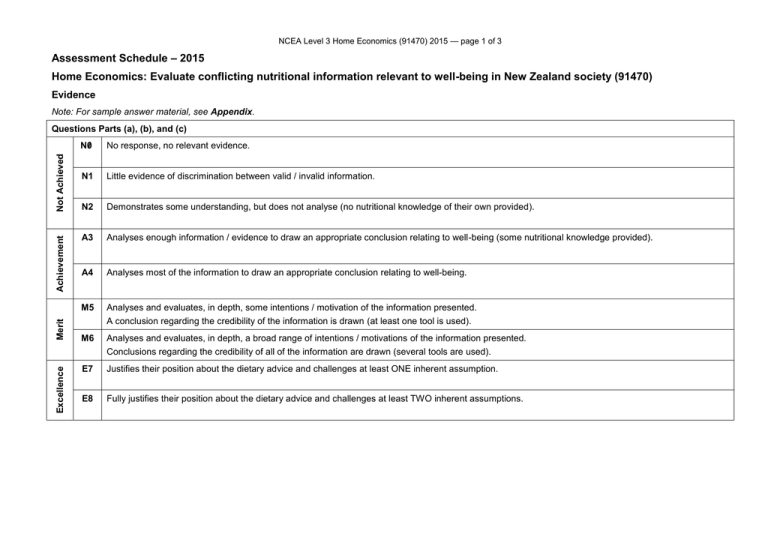– 2015 Assessment Schedule
advertisement

NCEA Level 3 Home Economics (91470) 2015 — page 1 of 3 Assessment Schedule – 2015 Home Economics: Evaluate conflicting nutritional information relevant to well-being in New Zealand society (91470) Evidence Note: For sample answer material, see Appendix. Merit Achievement Not Achieved Questions Parts (a), (b), and (c) N0/ No response, no relevant evidence. N1 Little evidence of discrimination between valid / invalid information. N2 Demonstrates some understanding, but does not analyse (no nutritional knowledge of their own provided). A3 Analyses enough information / evidence to draw an appropriate conclusion relating to well-being (some nutritional knowledge provided). A4 Analyses most of the information to draw an appropriate conclusion relating to well-being. M5 Analyses and evaluates, in depth, some intentions / motivation of the information presented. A conclusion regarding the credibility of the information is drawn (at least one tool is used). M6 Analyses and evaluates, in depth, a broad range of intentions / motivations of the information presented. Excellence Conclusions regarding the credibility of all of the information are drawn (several tools are used). E7 Justifies their position about the dietary advice and challenges at least ONE inherent assumption. E8 Fully justifies their position about the dietary advice and challenges at least TWO inherent assumptions. NCEA Level 3 Home Economics (91470) 2015 — page 2 of 3 Cut Scores Score range Not Achieved Achievement Achievement with Merit Achievement with Excellence 0–2 3–4 5–6 7–8 Appendix – Question Parts (a), (b), and (c): sample answer material (partial answer only) (a) Analyse the possible impacts on the well-being of New Zealand society, of the conflicting nutritional information presented in the resources. The information in Resource A could potentially have a positive impact on the well-being of New Zealand society. The information it contains may raise awareness amongst parents of the damaging effect that regular consumption of sugar-sweetened beverages (SSB’s) has on children’s teeth, and may lead to fewer operations in which children’s teeth have to be extracted. Rotten, painful teeth can lead to children needing time off school, which may interrupt learning, and in some cases, even delay it, not to mention that it may also lead to poor growth and development. For example, if a young child is unable to chew, they are limited in terms of the variety of foods they can eat, and so may not receive the full range of nutrients they need for normal growth and mental development. The cost to society is significant. Dr Beaglehole (Resource B) states that the cost to the New Zealand taxpayer in 2009 for multiple tooth extractions was more than $20 million. The most recent national nutrition surveys show that SSB’s contribute 26% of total sugar intake to the diets of children. The World Health Organisation (WHO) recommends no more than 10 per cent of a child’s daily energy should come from added sugars, or those found naturally in juices and honey, which equates to 12 teaspoons of added sugar a day. WHO also recommends further reducing daily energy from added sugar to below 5 % (around six teaspoons a day) to achieve the biggest health benefits. One 355 ml can of Coca-Cola® contains around 10 teaspoons of sugar, more than the six teaspoons recommended by WHO. Coca-Cola® is one of the top 40 best-selling food items in New Zealand supermarkets. Pricing for fizzy drink is often set at a level that makes it much more affordable than healthier options (bottled water and milk), so what used to be a ‘treat’ has become an ‘every day’ item, because it is the most affordable drink for many New Zealand families. NCEA Level 3 Home Economics (91470) 2015 — page 3 of 3 (b) Analyse the underlying intentions of the different information relating to sugar presented in the resources, drawing conclusions about the credibility of the information, and of those presenting it. The opinion piece (Resource B) written by Gerhard Sundborn, Rob Beaglehole, and Simon Thornley is a credible source of information. Dr Beaglehole is the Principal Dental Officer of the Nelson Marlborough DHB. The fact that he is a dentist and holds the position of “Principal Dental Officer” gives him credibility. He is motivated by his dislike of pulling rotten teeth out of the mouths of otherwise healthy children. His intention is to decrease the number of operations in New Zealand that remove rotten teeth as a direct result of SSB’s. Apart from national exposure, he has nothing else to gain. It could even be argued that if children’s dental health improved as a result of this opinion piece, he could potentially put himself and other dentists out of work. His opinion is unbiased. Simon Thornley’s credentials are described in Resource A. He is a public health physician. His opinion is also unbiased, and his credentials are highly credible. As a member of the advocacy group FIZZ, his intentions are to push for policies at local and national levels to limit the advertising, restrict the marketing, and raise the purchasing prices of, and ultimately curb the sales of, sugary drinks. He too wants to raise awareness of the harms sugary drinks pose to health. He has nothing personally to gain through his actions. He also discloses who has funded his research, and he appears not to be sponsored by any business in the food industry. On the other hand, Katherine Rich is the Chief Executive of the New Zealand Food & Grocery Council, and while she presents some compelling arguments (Resource C), her opinion is less credible because she represents the interests of the food industry who are primarily motivated by profit. Her opinion is therefore not unbiased. The information she presents in regard to sugar and health is emotive, and she uses very little New Zealand evidence to support her arguments. “Know Sugar” (Resource D) is nothing more than promotional material for the Kellogg’s® Cereal Company. Kellogg’s® produces sugary cereal products such as Frosties®, Coca Pops®, and Froot Loops®. The promotion of these products is deliberately targeted at children. It is not a credible source of information. The references it cites in all likelihood have been “cherry-picked” and refer to studies that support their viewpoint and cast sugar in a good light. (c) Evaluate the various positions taken in relation to sugar and well-being in New Zealand in the resources. Draw a conclusion using reasoned arguments from your own nutritional knowledge and understanding. Katherine Rich (Resource C) is promoting the idea that sugar is not the problem: poor choices and bad diets are. While individuals are responsible for what they eat, this is only part of the picture. Given that 60% of obesity is genetic, placing individuals who have a predisposition to obesity in an environment in which sugar (in the form of SSB’s) is cheap, highly accessible, and heavily promoted, and then expecting them to act responsibly, is not a realistic solution. While parents have a role to play in choosing the best food for their children’s well-being, the odds of them doing this are heavily stacked against them. There is a mismatch between what the food industry suggests and what some families can realistically do to ensure their children eat a healthy diet and get the exercise they need. The food industry would also argue that the cost of putting a tax on SSB’s would be considerably more than the $2 million needed to address the medical costs of a small number of children with bad teeth. However, the negative effects of SSB’s on well-being are not limited to just children’s teeth. As Dr Beaglehole implies (Resource B), the cost of obesity and diabetes in adults and children needs to be considered too. SSB’s are only one of many regularly consumed, manufactured foods that contain hidden sugar. The 2008 / 2009 Adult Nutrition Survey reported that New Zealand males consume on average 120 g of added sugar per day (30 teaspoons) and New Zealand females 96 g of added sugar per day (24 teaspoons). These amounts are much more than the WHO recommendations (adults and children should consume around 12 teaspoons of added sugar per day). In nutritional surveys, people typically under-report their consumption of “sugary” foods, so the amount of sugar the average New Zealander is consuming is likely to be more than that reported. The general population is also largely unaware of how much sugar many foods contain, making keeping track of how much sugar is eaten over a day, extremely difficult. In view of this, Katherine Rich’s solution – that people just need to balance energy in with energy out – is an unrealistic one. New Zealanders cannot exercise their way out of this problem.

